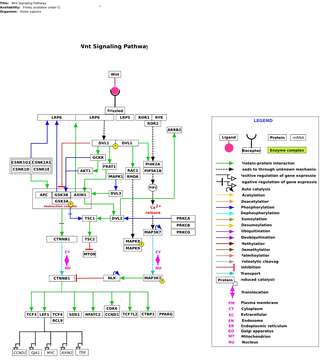Wnt Signaling Pathway (Homo sapiens)

Description:
Summary.mw-parser-output table.commons-file-information-table,.mw-parser-output.fileinfotpl-type-information{border:1px solid #a2a9b1;background-color:#f8f9fa;padding:5px;font-size:95%;border-spacing:2px;box-sizing:border-box;margin:0;width:100%}.mw-parser-output table.commons-file-information-table>tbody>tr,.mw-parser-output.fileinfotpl-type-information>tbody>tr{vertical-align:top}.mw-parser-output table.commons-file-information-table>tbody>tr>td,.mw-parser-output table.commons-file-information-table>tbody>tr>th,.mw-parser-output.fileinfotpl-type-information>tbody>tr>td,.mw-parser-output.fileinfotpl-type-information>tbody>tr>th{padding:4px}.mw-parser-output.fileinfo-paramfield{background:#ccf;text-align:right;padding-right:0.4em;width:15%;font-weight:bold}.mw-parser-output.commons-file-information-table+table.commons-file-information-table,.mw-parser-output.commons-file-information-table+div.commons-file-information-table>table{border-top:0;padding-top:0;margin-top:-8px}@media only screen and (max-width:719px){.mw-parser-output table.commons-file-information-table,.mw-parser-output.commons-file-information-table.fileinfotpl-type-information{border-spacing:0;padding:0;word-break:break-word;width:100%!important}.mw-parser-output.commons-file-information-table>tbody,.mw-parser-output.fileinfotpl-type-information>tbody{display:block}.mw-parser-output.commons-file-information-table>tbody>tr>td,.mw-parser-output.commons-file-information-table>tbody>tr>th,.mw-parser-output.fileinfotpl-type-information>tbody>tr>td,.mw-parser-output.fileinfotpl-type-information>tbody>tr>th{padding:0.2em 0.4em;text-align:left;text-align:start}.mw-parser-output.commons-file-information-table>tbody>tr,.mw-parser-output.fileinfotpl-type-information>tbody>tr{display:flex;flex-direction:column}.mw-parser-output.commons-file-information-table+table.commons-file-information-table,.mw-parser-output.commons-file-information-table+div.commons-file-information-table>table{margin-top:-1px}.mw-parser-output.fileinfo-paramfield{box-sizing:border-box;flex:1 0 100%;width:100%}} Description: English: WNT signal, through the canonical pathway, controls cell fate determination and through the non-canonical pathway controls cell movement and tissue polarity. The name "wnt" is a fusion of two terms, wg derived from the Drosophila gene wingless (wg) and int derived from the proto-oncogene integration-1, which is the mammalian homolog of wg. ß-catenin is the key regulated effector of Wnt, involved in canonical signaling. Free ß-catenin is bound by a multiprotein "destruction complex". The ß-catenin destruction complex is comprised of ß-catenin, scaffold proteins (APC, AXIN) and serine/threonine kinases that phosphorylate ß-catenin casein kinase 1 (CSNK1A1, CSNK1D, CSNK1E, CSNK1G1) and GSK3B. The sequential phosphorylation of ß-catenin by casein kinase 1 and GSK3 is recognised by an SCF-class E3-ubiquitin ligase, which targets it for polyubiquitination and proteosomal destruction. Canonical WNT signals are transduced through a two-part receptor, a seven-transmembrane Frizzled (FZD) and low density lipoprotein receptor-related protein 5/6 (LRP5/LRP6) to a ß-catenin (CTNNB1) signaling cascade. On recruitment of deshevelled (DVL1) to FZD and AXIN to LRP6, ß-catenin destruction complex disassembles leading to its stabilization and nuclear accumulation. Nuclear ß-catenin binds to T-cell factor/lymphoid enhancer factor (TCF/LEF) family of transcription factors and Legless family docking protein, BCL9. These activate the transcription of Wnt target genes CCND1, MYC. Non-canonical WNT signaling diverges downstream after being transduced through FZD family receptors and co-receptors, ROR2 and RYK. This pathway does not involve ß-catenin-mediated gene expression. Small G proteins such as RAC1, RHOA and downstream effectors of RAC including JNK are DVL-dependant effector molecules of the non-canonical pathway. These have been implicated in cytoskeletal rearrangement, dendrite growth and control of cell polarity and orientation. Nemo-like kinase (NLK) and nuclear factor of activated T cells (NFAT) are Ca2+-dependant effectors of the non-canonical pathway. NLK inhibits canonical pathway by phosphorylation of TCF/LEF family transcription factors. NFAT transcription factor is implicated in convergent extension during early embryogenesis and carcinogenic metastasis. Please access this pathway at NetSlim database. Date: 31 May 2018. Source: https://www.wikipathways.org/index.php/Pathway:WP363. Author: Kristina Hanspers, Shamith Samarajiwa, Sharona Elgavish, Thomas Kelder, et al.
Included On The Following Pages:
- Life (creatures)
- Cellular (cellular organisms)
- Eukaryota (eukaryotes)
- Opisthokonta (opisthokonts)
- Metazoa (Animal)
- Bilateria
- Deuterostomia (deuterostomes)
- Chordata (Chordates)
- Vertebrata (vertebrates)
- Gnathostomata (jawed fish)
- Osteichthyes
- Sarcopterygii (Lobe-finned fishes)
- Tetrapoda (terrestrial vertebrates)
- Amniota (amniotes)
- Synapsida (synapsids)
- Therapsida (therapsid)
- Cynodontia (cynodonts)
- Mammalia (mammals)
- Theria (Therians)
- Eutheria (eutherian)
- Placentalia (placental)
- Boreoeutheria
- Euarchontoglires
- Euarchonta
- Primates (primates)
- Haplorrhini ("monkeys, apes, and tarsiers")
- Anthropoidea
- Catarrhini
- Hominoidea (ape)
- Hominidae (great apes and humans)
- Homininae (hominine)
- Homo (Humans)
- Homo sapiens (Human)
This image is not featured in any collections.
Source Information
- license
- cc-by-sa-3.0
- copyright
- Kristina Hanspers, Shamith Samarajiwa, Sharona Elgavish, Thomas Kelder, et al.
- creator
- Kristina Hanspers, Shamith Samarajiwa, Sharona Elgavish, Thomas Kelder, et al.
- source
- https://www.wikipathways.org/index.php/Pathway:WP363
- original
- original media file
- visit source
- partner site
- Wikimedia Commons
- ID


